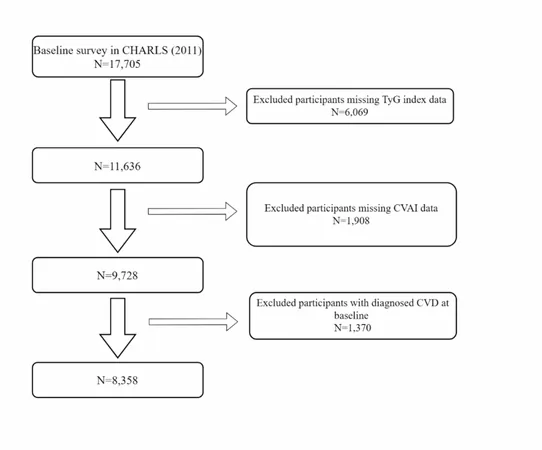
Are You At Risk of Cardiovascular Disease? The Surprising Link Between Insulin Resistance and Belly Fat Revealed!
2024-11-27
Author: Wei Ling
Introduction
Cardiovascular disease (CVD) remains the leading cause of death worldwide, claiming 31% of all fatalities annually. The global burden of CVD has escalated alarmingly from 271 million cases in 1990 to over 523 million today, corresponding to a staggering 54% increase in deaths—from 12.1 million to 18.6 million. In China, the statistics are equally troubling, with CVD accounting for 40% of total mortality and significantly impacting public health. In 2016 alone, an estimated 94 million individuals in China were living with CVD, with 61% of those deaths attributed to atherosclerotic cardiovascular disease (ASCVD).
Insulin Resistance and Cardiovascular Health
The study presents a ground-breaking analysis on how the triglyceride-glucose (TyG) index—a marker commonly used to detect insulin resistance (IR)—interacts with visceral adiposity (fat stored around organs) to influence cardiovascular health. Insulin resistance, a common condition in type 2 diabetes, is well-known for contributing to other metabolic irregularities like hypertension, dyslipidemia, and hyperglycemia, which all serve as risk factors for CVD. The TyG index has emerged as a convenient and low-cost surrogate for measuring IR, providing a strong correlation with cardiovascular risks.
The Role of TyG Index and Visceral Fat
Emerging findings suggest that not only does the TyG index indicate IR, but it may also play a critical role in linking IR to increased cardiovascular risk through various metabolic pathways. These encompass lipid metabolism disruptions, chronic inflammation, and endothelial dysfunction—all factors that significantly escalate chances of adverse cardiovascular outcomes such as heart failure.
Visceral Adipose Tissue as a Risk Factor
Simultaneously, visceral adipose tissue (VAT), particularly when accumulated in excess, is recognized as an independent risk factor for CVD. Compared to subcutaneous fat, VAT poses an even higher cardiometabolic risk due to its metabolic activity. Unfortunately, traditional imaging techniques that measure visceral fat can be prohibitively expensive and time-consuming. This challenge has led researchers to develop alternative, effective metrics such as the Chinese visceral adiposity index (CVAI), specifically designed for the Asian population. CVAI effectively captures the nuances of visceral obesity and can predict the risks for diabetes and CVD.
Study Objectives and Findings
This pivotal study aims to dissect the interplay between the TyG index and CVAI, exploring how these factors collectively influence CVD risk. Drawing on data from the China Health and Retirement Longitudinal Study (CHARLS), which surveyed thousands of residents over a decade, researchers analyzed health outcomes linked to both insulin resistance and visceral fat levels.
The findings uncovered that individuals with a low TyG index but high CVAI had the highest risk for developing CVD. This remarkable data indicates the need for a deeper understanding of how both insulin resistance and visceral fat contribute to CVD, allowing for more tailored assessment and intervention strategies in the fight against this pervasive health crisis.
Conclusion
As with all research, limitations exist—this study is observational in nature, thus establishing causation is out of reach. Other confounding factors such as diet, physical activity, and socioeconomic status may also play a role in influencing CVD risk. Furthermore, alternative methods for assessing insulin levels and measuring visceral fat accurately could enhance future research endeavors.
In conclusion, as the prevalence of cardiovascular diseases continues to rise, understanding the complex relationships between insulin resistance, visceral fat accumulation, and their combined impact on health is crucial. By promoting awareness around the TyG index and CVAI, we can heighten the focus on preventive measures and possibly reshape the future of cardiovascular health strategies. Do you know your TyG index? Discovering that information could be your first step towards a healthier heart!




 Brasil (PT)
Brasil (PT)
 Canada (EN)
Canada (EN)
 Chile (ES)
Chile (ES)
 España (ES)
España (ES)
 France (FR)
France (FR)
 Hong Kong (EN)
Hong Kong (EN)
 Italia (IT)
Italia (IT)
 日本 (JA)
日本 (JA)
 Magyarország (HU)
Magyarország (HU)
 Norge (NO)
Norge (NO)
 Polska (PL)
Polska (PL)
 Schweiz (DE)
Schweiz (DE)
 Singapore (EN)
Singapore (EN)
 Sverige (SV)
Sverige (SV)
 Suomi (FI)
Suomi (FI)
 Türkiye (TR)
Türkiye (TR)